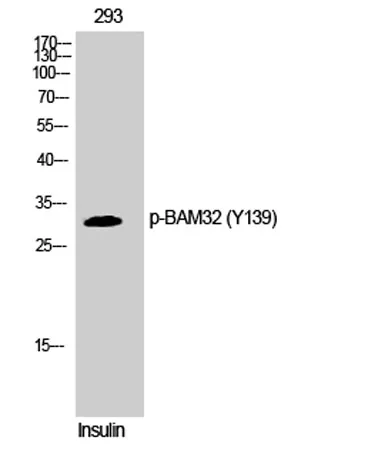BAM32 (phospho Tyr139) rabbit pAb
CAT:
855-ES5538-01
Size:
50 μL
Price:
Ask
- Availability: 24/48H Stock Items & 2 to 6 Weeks non Stock Items.
- Dry Ice Shipment: No




BAM32 (phospho Tyr139) rabbit pAb
- Description: Function: May act as a B-cell-associated adapter that regulates B-cell antigen receptor (BCR)-signaling downstream of PI3K. induction: Upon B-cell activation. PTM: Phosphorylated on tyrosine residues. similarity: Contains 1 PH domain. similarity: Contains 1 SH2 domain. subcellular location: Membrane-associated after cell stimulation leading to its translocation. subunit: Interacts with PtdIns (3, 4, 5)P3 and PLCG2. In vitro, interacts with PtdIns (3, 4)P2. tissue specificity: Highly expressed in placenta and lung, followed by brain, heart, kidney, liver, pancreas and skeletal muscle. Expressed by B-lymphocytes, but not T-lymphocytes or nonhematopoietic cells.
- Synonyms: DAPP1; BAM32; HSPC066; Dual adapter for phosphotyrosine and 3-phosphotyrosine and 3-phosphoinositide; hDAPP1; B lymphocyte adapter protein Bam32; B-cell adapter molecule of 32 kDa
- Gene ID: 27071
- UniProt: Q9UN19
- Cellular Locus: Cytoplasm. Membrane ; Peripheral membrane protein. Membrane-associated after cell stimulation leading to its translocation.
- Host: Rabbit
- Species Reactivity: Human, Mouse
- Immunogen: The antiserum was produced against synthesized peptide derived from human DAPP1 around the phosphorylation site of Tyr139. AA range:105-154
- Clonality: Polyclonal
- Validated Applications: WB, IHC, IF, ELISA
- Stability: 1 year
- Concentration: 1 mg/mL
- Dilution: Western Blot: 1/500 - 1/2000. Immunohistochemistry: 1/100 - 1/300. Immunofluorescence: 1/200 - 1/1000. ELISA: 1/5000. Not yet tested in other applications.
- Molecular Weight: 32kD
- Storage Conditions: PBS with 0.02% sodium azide and 50% glycerol pH 7.4. Store at -20°C. Avoid repeated freeze-thaw cycles.
